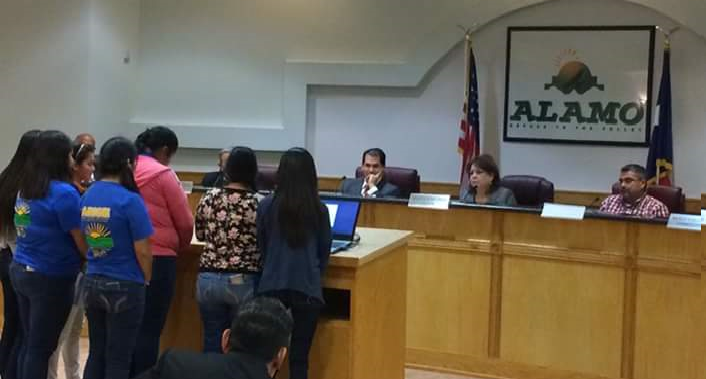• Aurelio M. Montemayor, M.Ed. • IDRA Newsletter • May 2016 •


Ariss Cocino and Ramona Casas conduct a survey with colonia residents and disseminate information about the environmental pollution in the neighborhood. Photo courtesy of ARISE.
Young people informing their community about environmental problems, presenting about their experiences with dual credit classes in high school, and organizing field trips to a local college – all of these are aspects of leadership modeled by youths from neighborhoods that outsiders often claim don’t value education.
The community-based organization, ARISE (A Resource in Service for Equality), has had a dynamic youth involvement and youth leadership approach since its inception in 1987 by Sr. Gerrie Naughton. Early on, ARISE members saw a need for summer activities for children in the most-isolated colonias where city and county services were lacking or nonexistent.
Every June, hundreds of children now participate in games, learning activities and physical activities that are wholesome and entertaining. To achieve this with very little money, teenagers and pre-teens from the communities take on the role of mentors and guides for the children. This volunteer activity has persisted, and there are now many adults today who remember participating as children or youth mentors.
Just as ARISE has always had a strong base in seeking social justice, the youths have taken on important community issues. For example, training in ecological justice helped them focus on some pervasive problems in their neighborhoods. One that everyone there lives with is a stench that comes from stagnant water. A group of 20 youths went through some training that highlighted issues of environmental justice, and they launched a campaign to inform the community and to present testimony to the city council and the county


Bricieda Cosino, Andrea Guzmán, Lizbeth Ramos, Abril Cosino, Yajaira González, Ariss Cosino and Lupita Pérez present findings and make requests of the elected officials in the Alamo City Council. Photo courtesy of ARISE.
commissioners on the issue.
One offending source of the pollution is a water treatment plant that belongs to the city of Alamo, Texas. As an interim measure, the youths were able to secure large fans at the plant to disperse the offending odors more quickly. And some long-term plans have been put in place to remedy the situation altogether. Other pockets of stagnant water also are being targeted for clean-up.
The students are carrying out their expanded campaign to inform residents with house-to-house fliers and informational visits about the problem, their rights and what actions the community can take to resolve these threats to health and well-being in their neighborhoods. The group, Jóvenes del Valle en Acción (Valley Youths in Action), was even able to have their issue taken to the United Nations through the cooperation of some Sisters (nuns) who live in New York.
Relatedly, the students have demonstrated their leadership in their love for their community by getting services from the county to pick up trash and large objects where previously only brush was collected. When elderly folk don’t have the strength or ability to put out large objects for trash collection, the youths do it. And they patrol their neighborhoods to reduce trash and eyesores.
These young people range in ages from 14 to 20, from middle school to college. Their leadership has been demonstrated in their information campaign and their testimony before city, county and federal agencies. And they are currently collecting signatures for a large public meeting where they will provide testimony.
The youths are all ARISE volunteers and, along with their parents, are members of the ARISE South Tower Comunitario PTA. They have learned through this project what ecology means and are now proficient in terms like environmental impact. Science has become very real and comprehensible through this project.
Using an example like this, it would be quite easy for an enterprising science teacher to make connections in the classroom. The teacher could lead students to introduce the elements and the biological processes that cause such a stench; to identify the health hazards that local pollution brings; and to integrate so many other concepts that would otherwise be dull, uninteresting and unintelligible if only presented with a science textbook and a lecture.
These youth know well the pronouncements that are made about them by people who are ill informed. And it is true that these teenagers live in extremely poor neighborhoods. It is also true that they are committed, compassionate young people surrounded by supportive families and a community that is listening.
Aurelio M. Montemayor, M.Ed., is a senior education associate at IDRA. Comments and questions can be directed to him via email aurelio.montemayor@idra.org.
This article was written in part from information given by Lupita Perez, ARISE young staff member and supporter of the youth projects, and Eva Carranza, current and founding president of the ARISE South Tower Comunitario PTA.
![]()
![]()
![]()
See our photo slideshow of Youths in Action
[©2016, IDRA. This article originally appeared in the May 2016 IDRA Newsletter by the Intercultural Development Research Association. Permission to reproduce this article is granted provided the article is reprinted in its entirety and proper credit is given to IDRA and the author.]


